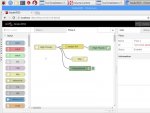Oren,
Just thought that I would report back. I purchased an I2C LCD screen to try this out. It was fairly simple and straightforward. Here is the LCD I purchased:
https://www.amazon.com/gp/slredirec...23631353&id=704940962322670&widgetName=sp_atf
Or search Amazon for Keyestudio 1602
Simply hook up four wires. Connect to the 5 v. power pin, you won't hurt your pi.
Here is the article that I followed to get it working:
How to Setup an I2C LCD on the Raspberry Pi - Circuit Basics
Once you get it to scroll or blink a message or whatever you want, then you can start integrating with TTD.
Create a file in your TTD folder called blink.py
Paste this following text into that file:
import I2C_LCD_driver
import time
import argparse
parser = argparse.ArgumentParser()
parser.add_argument("description")
args = parser.parse_args()
desc = args.description
mylcd = I2C_LCD_driver.lcd()
for x in range (1,10):
mylcd.lcd_display_string(desc)
time.sleep(1)
mylcd.lcd_clear()
time.sleep(1)
Then save it.
Note that the I2C_LCD_driver file needs to be in your TTD folder also.
Now, in your tones.cfg file add an alert_command = python blink.py [d] for each tone set that you want to display on the LCD.
When that tone set decodes it will send the Description = parameter to the LCD screen and blink it ten times.
The CircuitBasics page above describes now to modify the code if you want it scrolling or some other option.
It doesn't handle stacked tones well.
With some modifications, I expect that it would also work with and OLED display.
Good luck with it.
Jim




